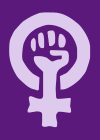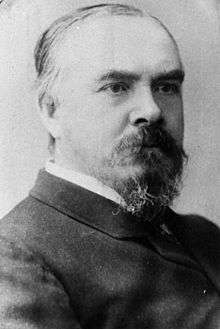Women's suffrage in New Zealand
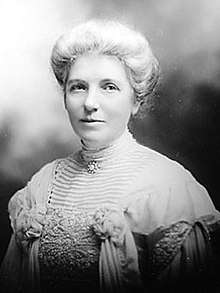
Women's suffrage in New Zealand was an important political issue in the late nineteenth century. In early colonial New Zealand, as in other European societies, women were excluded from any involvement in politics. Public opinion began to change in the latter half of the nineteenth century, however, and after years of effort by women's suffrage campaigners, led by Kate Sheppard, New Zealand became the first self-governing colony in the world in which all women had the right to vote in parliamentary elections.[1]
The Electoral Bill granting women the franchise was given Royal Assent by Governor Lord Glasgow on 19 September 1893. Women voted for the first time in the election held on 28 November 1893 (elections for the Māori electorates were held on 20 December). Also in 1893, Elizabeth Yates became Mayor of Onehunga, the first time such a post had been held by a woman anywhere in the British Empire.[2]
History
The struggle for women's suffrage
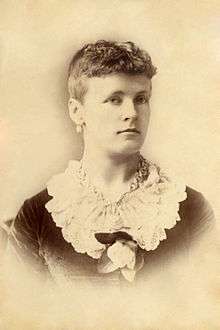
Women's suffrage was granted after about two decades of campaigning throughout New Zealand, by women who included Kate Sheppard and Mary Ann Müller. The New Zealand branch of the Women's Christian Temperance Union (WCTU) led by Anne Ward was particularly instrumental in the campaign. Influenced by the American branch of the Women's Christian Temperance Movement and the philosophy of thinkers like Harriet Taylor Mill and John Stuart Mill, the movement argued that women could bring morality into democratic politics.[3] Opponents argued instead that politics was outside women's 'natural sphere' of the home and family. Suffrage advocates countered that allowing women to vote would encourage policies which protected and nurtured families.
WCTU campaigners and suffragettes organised and delivered a series of petitions to Parliament: over 9,000 signatures were delivered in 1891, followed by a petition of almost 20,000 signatures in 1892, and finally in 1893 nearly 32,000 signatures were presented – almost a quarter of the adult European female population of New Zealand.[3]
From 1887, various attempts were made to pass bills enabling female suffrage, the first of which was authored by Julius Vogel, the 8th Premier of New Zealand. Each bill came close to passing. Several electoral bills that would have given adult women the right to vote were passed in the House of Representatives but defeated in the upper Legislative Council.
In 1891 Walter Carncross moved an amendment that was intended to make a new bill fail in the Legislative Council. His amendment was for women to become eligible to be voted into the House of Representatives and in this way Carncross ensured that the conservative Upper House would reject the bill. This tactic infuriated the suffragette Catherine Fulton, who organised a protest at the 1893 election.[4] An 1892 Electoral Bill, introduced by John Ballance, provided for the enfranchisement of all women, but controversy over an impractical postal vote amendment caused its abandonment.

By 1893 there was considerable popular support for women's suffrage. The 1893 Women's Suffrage Petition was presented to Parliament and a new Electoral Bill passed through the Lower House with a large majority. During debate, there was majority support for the enfranchisement of Māori as well as Pākehā women; the inclusion of Māori women was championed by John Shera, who was married to a part-Māori.[5] Lobbyists for the liquor industry, concerned that women would force the prohibition of alcohol, petitioned the Upper House to reject the bill. Suffragists responded with mass rallies and telegrams to Members of Parliament. They gave their supporters in Parliament white camellias to wear in their buttonholes. The Upper House was divided on the issue, and Premier Richard Seddon hoped to stop the bill.[6]
Seddon needed one more vote to defeat the measure in the Upper House. A new Liberal Party councillor, Thomas Kelly, had decided to vote in favour of the measure, but Seddon obtained his consent by wire to change his vote. Seddon's manipulation incensed two other councillors William Hunter Reynolds and Edward Cephas John Stevens, so they changed sides and voted for the bill, allowing it to pass by 20 votes to 18 on 8 September 1893. The two opposition councillors had been opposed to women's suffrage without the 'electoral rights' safeguard of postal voting, seen as necessary to allow all women in isolated rural areas to vote, although seen by the Liberals as rendering the vote open to manipulation by husbands or employers.[6]

Eighteen legislative councillors petitioned the new governor, Lord Glasgow, to withhold his consent in enacting the law, but on 19 September 1893 the governor consented and The Electoral Act 1893 gave all women in New Zealand the right to vote.[1]
Both the Liberal government and the opposition subsequently claimed credit for the enfranchisement of women and sought women's newly acquired votes on these grounds.[7]
Further advances in women's political rights
In 1893, Elizabeth Yates became the first woman in the British Empire to become mayor, though she held the post in Onehunga, a city now part of Auckland, only for about a year.[8] In 1926, Margaret Magill, an openly lesbian teacher and school administrator[9] was elected to serve on the Executive Board of the New Zealand Educational Institute (NZEI). She became president of the organization in 1933, and her election to that post marked the first time it had been held by a woman.[10][11]
Women were not eligible to be elected to the House of Representatives until 1919, when three women stood: Rosetta Baume (in Parnell for the Liberal Party), Ellen Melville (in Grey Lynn for the Reform Party), and Mrs Aileen Garmson (Cooke) (in Thames, as an "Independent Liberal").
Elizabeth McCombs was the first woman to win an election (to the Lyttelton seat held by her late husband, via widow's succession) in the 1933 by-election. She was followed by Catherine Stewart (1938), Mary Dreaver (1941), Mary Grigg (1942), Mabel Howard (1943), and Hilda Ross (1945). Grigg and Ross represented the National Party, while McCombs, Stewart, Dreaver and Howard were all from the Labour Party. The first Maori woman MP was Iriaka Ratana in 1949; she also succeeded to the seat held by her late husband.
Women were not eligible to be appointed to the New Zealand Legislative Council (the Upper House of Parliament) until 1941. The first two women (Mary Dreaver and Mary Anderson) were appointed in 1946 by the Labour Government. In 1950 the "suicide squad" appointed by the National Government to abolish the Legislative Council included three women: Cora Louisa Burrell of Christchurch, Ethel Marion Gould of Auckland and Agnes Louisa Weston of Wellington.
In 1989 Helen Clark became the first female Deputy Prime Minister. In 1997, the then-current Prime Minister Jim Bolger lost the support of the National Party and was replaced by Jenny Shipley, making her the first female Prime Minister of New Zealand. In 1999, Clark became the second female Prime Minister of New Zealand, and the first woman to gain the position at an election. In 2017, Jacinda Ardern became the third female Prime Minister of New Zealand, and the second woman to gain the position at an election.
The New Zealand Suffrage Centennial Medal 1993 was authorised by the Queen by Royal Warrant dated 1 July 1993, and was awarded to 546 selected persons in recognition of their contribution to the rights of women in New Zealand or to women's issues in New Zealand or both.[12]
 Kate Sheppard, New Zealand's leading suffrage campaigner, appears on the current New Zealand ten-dollar note.[13]
Kate Sheppard, New Zealand's leading suffrage campaigner, appears on the current New Zealand ten-dollar note.[13] Sophia Taylor, a suffragette leader from Northland, who opposed women standing for office.[14]
Sophia Taylor, a suffragette leader from Northland, who opposed women standing for office.[14] Mary Ann Müller, a pioneering campaigner for women's suffrage and other women's rights.[15]
Mary Ann Müller, a pioneering campaigner for women's suffrage and other women's rights.[15]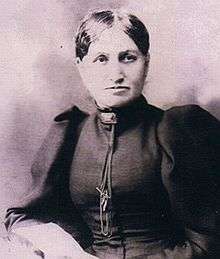 Elizabeth Yates, who in 1893 became the first female Mayor in the British Empire and the second in the world.[2]
Elizabeth Yates, who in 1893 became the first female Mayor in the British Empire and the second in the world.[2]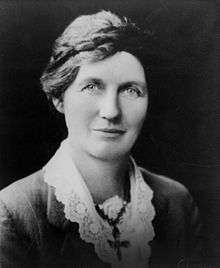
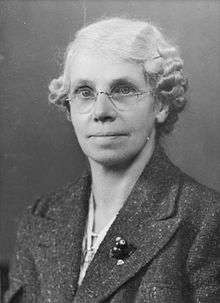
- Mary Dreaver, first woman to sit in the New Zealand Legislative Council, third female MP (1941).[18]
 Iriaka Ratana, the first female MP of Maori descent (1949).[19]
Iriaka Ratana, the first female MP of Maori descent (1949).[19]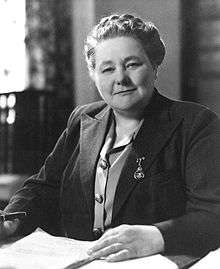
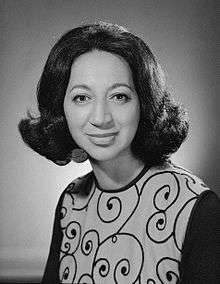 Whetu Tirikatene-Sullivan, New Zealand's longest serving female MP, 29 years between 1967 and 1996.[21]
Whetu Tirikatene-Sullivan, New Zealand's longest serving female MP, 29 years between 1967 and 1996.[21]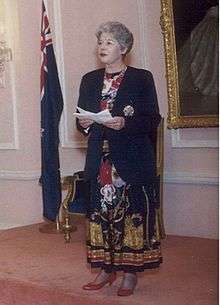
 Jenny Shipley, first female Prime Minister (1997–99).[23]
Jenny Shipley, first female Prime Minister (1997–99).[23] Helen Clark, second female Prime Minister (1999–2008). First female Deputy Prime Minister (1989).[23]
Helen Clark, second female Prime Minister (1999–2008). First female Deputy Prime Minister (1989).[23]
See also
References
- 1 2 "Women and the vote: Introduction". New Zealand History. Women's Suffrage. Wellington, New Zealand: New Zealand Ministry for Culture and Heritage. nd. Retrieved 13 February 2018.
- 1 2 Mogford, Janice C. "Yates, Elizabeth 1840-1848?–1918". Dictionary of New Zealand Biography. Ministry for Culture and Heritage. Retrieved 7 April 2011.
- 1 2 "Brief History of Women's Suffrage". NZ History.
- ↑ Entwisle, Rosemary. "Fulton, Catherine Henrietta Elliot – Biography". Dictionary of New Zealand Biography. Ministry for Culture and Heritage. Retrieved 29 July 2012.
- ↑ Binney, Judith, ed. (1968). The Shaping of History: Essays from the New Zealand Journal of History. Bridget Williams Books. p. xiii.
- 1 2 Grimshaw, pp 70–71, 92.
- ↑ Atkinson, Neill (2003). Adventures in Democracy: A History of the Vote in New Zealand. pp 84–94, 96.
- ↑ Atkinson, Neill (4 December 2017). "Elizabeth Yates". New Zealand History. Wellington, New Zealand: Ministry for Culture and Heritage. Archived from the original on 18 May 2017. Retrieved 15 September 2018.
- ↑ Laurie, Alison J. (2003). Lady-Husbands and Kamp Ladies: Pre-1970 Lesbian Life in Aotearoa/New Zealand (PDF) (PhD). Wellington, New Zealand: Victoria University of Wellington. p. 189. Archived (PDF) from the original on 21 May 2017. Retrieved 15 September 2018.
- ↑ "Margaret 'Maggie' Magill". NZEI Heritage. Wellington, New Zealand: New Zealand Educational Institute. n.d. Archived from the original on 19 June 2017. Retrieved 15 September 2018.
- ↑ "Beaches and Bathing". 119 (105). Wellington, New Zealand: The Evening Post. 6 May 1935. Retrieved 19 June 2017.
- ↑ New Zealand Honours: Distinctive NZ Honours Department of the Prime Minister and Cabinet
- ↑ Malcolm, Tessa (30 October 2012). "Sheppard, Katherine Wilson". Dictionary of New Zealand Biography. Te Ara – The Enclyclopedia of New Zealand. Retrieved 25 April 2016.
- ↑ Harris, Jan. "Sophia Louisa Taylor". Dictionary of New Zealand Biography. Ministry for Culture and Heritage. Retrieved 26 August 2016.
- ↑ "Müller, Mary Ann", Dictionary of New Zealand Biography
- ↑ Jean Garner. 'McCombs, Elizabeth Reid'. Dictionary of New Zealand Biography. Te Ara - the Encyclopedia of New Zealand, updated 13 November 2013.
- ↑ Nicholls, Roberta. "Stewart, Catherine Campbell". Dictionary of New Zealand Biography. Ministry for Culture and Heritage. Retrieved 10 November 2013.
- ↑ Laracy, Hugh. "Dreaver, Mary Manson - Biography". Dictionary of New Zealand Biography. Ministry for Culture and Heritage. Retrieved 22 July 2012.
- ↑ Ballara, Angela (1 September 2010). "Ratana, Iriaka Matiu - Biography". Dictionary of New Zealand Biography. Retrieved 6 December 2010.
- ↑ McAloon, Jim. "Howard, Mabel Bowden 1894 - 1972". Dictionary of New Zealand Biography. Ministry for Culture and Heritage. Retrieved 15 November 2011.
- ↑ "NZ's longest-serving female MP passes away". The New Zealand Herald. 22 July 2011. Retrieved 22 July 2011.
- ↑ McLean, Gavin (October 2006). The Governors: New Zealand's Governors and Governors-General. Otago University Press. ISBN 1-877372-25-0.
- 1 2 Skard, Torild (2014) "Jenny Shipley and Helen Clark" in Women of Power – Half a century of female presidents and prime ministers worldwide. Bristol: Policy Press, ISBN 978-1-44731-578-0
Further reading
- Dalziel, Raewynn. "Presenting the Enfranchisement of New Zealand Women Abroad" in Caroline Daley, and Melanie Nolan, eds. Suffrage and Beyond: International Feminist Perspectives (New York University Press, 1994) 42–64.
- Grimshaw, Patricia. Women's Suffrage in New Zealand (1988), the standard scholarly study
- Grimshaw, Patricia. "Women’s Suffrage in New Zealand Revisited: Writing from the Margins," Caroline Daley, and Melanie Nolan, eds. Suffrage and Beyond: International Feminist Perspectives (New York University Press, 1994) pp 25–41.
- Markoff, John. "Margins, Centers, and Democracy: The Paradigmatic History of Women's Suffrage," Signs: Journal of Women in Culture & Society (2003) 29#1 pp 85–116. compares NZ with Cook Islands & Finland in JSTOR
- Ramirez, Francisco O., Yasemin Soysal, and Suzanne Shanahan. "The Changing Logic of Political Citizenship: Cross-National Acquisition of Women’s Suffrage Rights, 1890 to 1990," American Sociological Review (1997) 62#5 pp 735–45. in JSTOR
Primary sources
- Lovell-Smith, Margaret, ed. The Woman Question: Writings by the Women Who Won the Vote (Auckland: New Women’s Press, 1992)
- Smith, William Sidney (1905). Outlines of the women's franchise movement in New Zealand. Christchurch: Whitcombe and Tombs, Limited.
